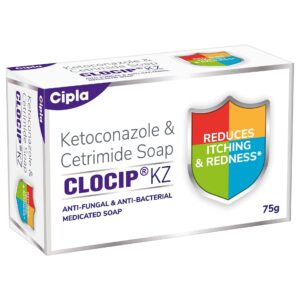CETRIMIDE + KETOCONAZOLE
Cetrimide: Cetrimide is a quaternary ammonium compound that is widely used as an antiseptic and disinfectant. It is commonly found in over-the-counter products such as wound cleansers, skin disinfectants, and certain dermatological creams.
Its primary use is to prevent infection in minor cuts, burns, and other injuries. Cetrimide works by disrupting the cell membranes of bacteria, fungi, and viruses, leading to their destruction and preventing further growth and spread of infection.
The drug is typically applied topically to the affected area. It is important to follow the instructions on the product label or as directed by a healthcare professional to ensure proper application. Cetrimide should be diluted with water before use, usually at a concentration of 0.1-1%.
Some common side effects of cetrimide include skin irritation, redness, and allergic reactions. If any of these side effects persist or worsen, it is advisable to consult a healthcare professional.
It is worth noting that cetrimide should not be used on deep or puncture wounds, severe burns, animal bites, or wounds with a lot of tissue damage. In these cases, a healthcare professional should be consulted for appropriate treatment.
Overall, cetrimide is a widely used antiseptic that serves as an effective option for preventing infection in minor injuries. However, it is important to use it as directed and seek medical advice if there are any concerns or persistent side effects.
Ketoconazole: Ketoconazole is an antifungal medication used to treat various fungal infections. It belongs to the class of drugs called azole antifungals.
The primary mechanism of action of ketoconazole is the inhibition of ergosterol synthesis, a critical component of fungal cell membranes. By doing so, it disrupts the integrity and function of the fungal cell membrane, leading to the death of the fungal organism.
Ketoconazole can be administered orally in the form of tablets or capsules, or topically in the form of creams, shampoos, or foams. The dosage and duration of treatment depend on the type and severity of the infection. It is important to follow the prescribed instructions and complete the full course of treatment to effectively clear the infection.
As with any medication, ketoconazole may have certain side effects. Common adverse effects include nausea, vomiting, abdominal pain, diarrhea, and dizziness. It can also cause liver damage, which is a rare but serious side effect. Signs of liver damage include yellowing of the skin or eyes, dark urine, pale stools, and persistent fatigue. If any of these symptoms occur, medical attention should be sought immediately.
Ketoconazole may interact with various medications, including certain anticoagulants, antacids, antivirals, and hormone-based contraceptives. It is essential to inform the healthcare provider about all current medications to avoid potential drug interactions.
Overall, ketoconazole is an effective antifungal drug used to treat various fungal infections. However, it is important to use it as prescribed and be aware of potential side effects or interactions with other medications. Regular monitoring of liver function may be necessary during treatment with ketoconazole.

